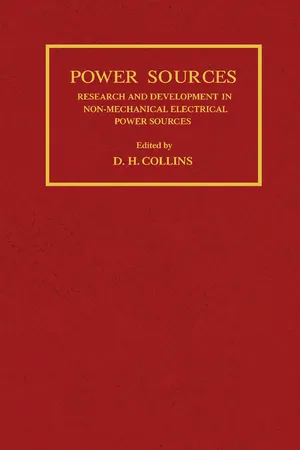
Research and Development in Non-Mechanical Electrical Power Sources
Proceedings of the 6th International Symposium Held at Brighton, September 1968
- 632 pages
- English
- PDF
- Available on iOS & Android
Research and Development in Non-Mechanical Electrical Power Sources
Proceedings of the 6th International Symposium Held at Brighton, September 1968
About This Book
Research and Development in Non-Mechanical Electrical Power Sources contains the proceedings of the 6th International Power Sources Symposium held in Brighton, UK, in September 1968. The papers explore research and development in non-mechanical sources of electric power such as lead-acid batteries, nickel-cadmium batteries, and solid state batteries. This book is comprised of 38 chapters and opens with a discussion on the charge acceptance of positive and negative electrodes in lead-acid cells. The following chapters deal with the effect of temperature and current density on the utilization of lead and lead oxide electrodes; anomalies of the negative plate in the lead-acid battery; curing of lead-acid battery plates; and specific properties of small closed lead accumulators using an immobilized electrolyte. Water-activated dry-charged lead-acid batteries, coated nickel electrodes, and nickel-cadmium batteries are also described. The final chapter is devoted to the methods of making GeSi alloys, their properties, and their use in thermoelectric generators. This monograph will be a valuable resource for electrical engineers.
Frequently asked questions
Information
Table of contents
- Front Cover
- Power Source 2 1968: Research and Development in Non-Mechanical Electrical Power Sources
- Copyright Page
- Table of Contents
- Foreword
- CHAPTER 1. CHARGE ACCEPTANCE OF THE LEAD CELL AT VARIOUS CHARGING RATES AND TEMPERATURES
- CHAPTER 2. THE EFFECT OF TEMPERATURE AND CURRENT DENSITY ON THE UTILIZATION OF LEAD AND LEAD OXIDE ELECTRODESI
- CHAPTER 3. ANOMALIES OF THE NEGATIVE PLATE IN THE LEAD–ACID BATTERY
- CHAPTER 4. THE CURING OF LEAD-ACID BATTERY PLATES
- CHAPTER 5. SPECIFIC PROPERTIES OF SMALL CLOSED LEAD ACCUMULATORS USING AN IMMOBILIZED ELECTROLYTE
- CHAPTER 6. WATER-ACTIVATED DRY-CHARGED LEAD–ACID BATTERIES
- CHAPTER 7. A STUDY OF SOME OF THE CRYSTALLOGRAPHIG AND MICROSCOPIC ASPECTS OF THE CURING OF POSITIVE LEAD–ACID BATTERY PLATES
- CHAPTER 8. THE DISTRIBUTION OF POTENTIAL OVER DISCHARGING LEAD–ACID BATTERY PLATES
- CHAPTER 9. ON THE SELF-DISCHARGE OF A NICKEL OXIDE ELECTRODE
- CHAPTER 10. CURRENT DISTRIBUTION AND pH GRADIENTS IN A MODEL OF A BATTERY PLATE
- CHAPTER 11. COATED NICKEL ELECTRODES
- CHAPTER 12. RAPID RECHARGING OF NICKEL–CADMIUM BATTERIES
- CHAPTER 13. PARAMETRIC CHARGE STUDIES FOR AEROSPACE NICKEL–CADMIUM BATTERIES
- CHAPTER 14. COMPUTER USE IN AUTOMATIC DATA ACQUISITION SYSTEMS FOR BATTERY TESTING
- CHAPTER 15. ION-EXCHANGE MEMBRANES AS SEPARATORS FOR ORGANIC ELECTROLYTE RECHARGEABLE SYSTEMS
- CHAPTER 16. A POTENTIAL–TIME STUDY OF THE MASS TRANSFER PHENOMENA DUE TO THE LITHIUM IONS IN NON-AQUEOUS ELECTROLYTES
- CHAPTER 17. HIGH-ENERGY DENSITY LITHIUM–NICKEL FLUORIDE NON–AQUEOUS BATTERIES
- CHAPTER 18. THE SULFUR ELECTRODE
- CHAPTER 19. ELECTRODE POTENTIALS AND RELATED PROPERTIES OF SOME POTASSIUM CONTAINING α-MANGANESE DIOXIDES
- CHAPTER 20. PHYSICAL PROPERTIES OF MIXTURES OF CARBON AND MANGANESE DIOXIDE
- CHAPTER 21. SHELF LIFE OF LECLANCHÉ BATTERIES
- CHAPTER 22. SOME NEW REFILL CELL SYSTEMS
- CHAPTER 23. LOW-TEMPERATURE PERFORMANCE OF THE ZINC–MERCURIC OXIDE SYSTEM
- CHAPTER 24. SOLID STATE BATTERIES
- CHAPTER 25. A KINETIC STUDY OF THE ZINC ELECTRODE BY MODIFIED TECHNIQUES
- CHAPTER 26. A COMPARISON OF AMALGAMATED AND NON-AMALGAMATED ZINC ELECTRODES
- CHAPTER 27. ZINC–AIR BATTERY SYSTEMS
- CHAPTER 28. AIR–METAL CELL SYSTEMS
- CHAPTER 29. HIGH RATE ZINC–OXYGEN BATTERIES
- CHAPTER 30. ON THE OPERATING MECHANISM OF A HYDROPHILIG POROUS GAS ELECTRODE
- CHAPTER 31. HIGH CURRENT DENSITY HYDROGEN ELECTRODES
- CHAPTER 32. THE STUDY OF ELECTRODES FOR THE HYDRAZINE–OXYGEN FUEL CELL
- CHAPTER 33. HYDROCARBON AND METHANOL LOW TEMPERATURE FUEL CELL SYSTEMS
- CHAPTER 34. THEORETICAL CONSIDERATION OF A MOLTEN CARBONATE FUEL CELL RUNNING ON NATURAL GAS
- CHAPTER 35. ASSESSMENT OF THE FUTURE OF FUEL CELLS AND RECHARGEABLE BATTERIES IN RAIL TRACTION
- CHAPTER 36. FUEL CELL–BATTERY POWER SOURCES
- CHAPTER 37. THE DEVELOPMENT OF FUEL CELLANCILLARY SYSTEMS AND COMPONENTS
- CHAPTER 38. THE 'METHODS OF MAKING GeSi ALLOYS,THEIR PROPERTIES AND THEIR USE IN THERMOELECTRIC GENERATORS